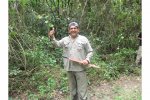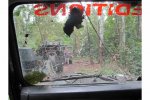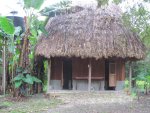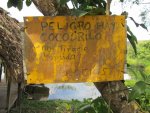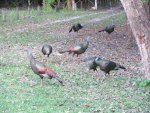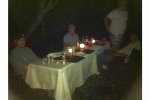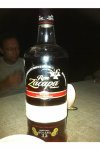So after we all pack up our personal gear, we gather back at the dining area to begin breaking down all the site gear for loadup. As we’re doing this, someone calls out “Hey, there’s a dead baby boa over here!”. It was found in the space between our site and the ranger station by the water, which is the clearing where other vehicles would pass through if they were transiting the campground to continue North into the jungle.

The dead snake then triggers my faint memory of hearing some vehicles passing through the area in convoy during the early AM hours as I lay in my hammock. It is the realization that we are not alone, which is an easy state of mind to slip into within darkness of the Peten. I failed to mention previously that there are a few rangers that are stationed at this extremely remote outpost, and they have very spartan living quarters on the 2nd floor of the ranger station. They are extremely friendly and seem to be happy despite being up there for weeks if not months at a time. We say goodbye to them after we load up, and after a intervehicular comms check on the NLX commercial radios, James and I take the lead heading into a previously unobserved small break in the jungle edge on the North side of the campground. As we roll, James says his goal is to get to the site by lunch time. Sounds like a good goal to me! The Peten always gets a vote though, so let’s consider it a stretch goal.
As we begin down the jungle trail, James picks up a pretty good pace, moving at what seemed like lightning speed to me. The conditions on the trail in the first 10 minutes are fantastic, from a traction standpoint. Solid ground allows for 3rd and 4th gear to be used in low range, and as mentioned before James sure knows how to drive. These trails are much narrower than the trail getting into this campground, which became clearly obvious that they are even less traveled than the prior days trails into the campground. For the first 20-30 minutes, I would guess there is no more than 6” of clearance on either side of the Defenders, and Defenders are pretty narrow as it is. Being a military officer, I think about what it would be like to try and maneuver a US military unit through here, and I laugh to myself. The HMMVW would not have been able to make it through the first 500 meters of the jungle from 2 days ago, without widening the trail through it’s entire length (with few exceptions).
Moving along along at 15-20 mph with no clearance, my mind drifts to a different thought. The sensation of the climbing and descents along the area topography, and the side to side swaying of the Defender as it weaves along, reminds me of the exact feeling I used to get long ago at amusement parks riding roller coaster type rides. Then I laugh to myself about that feeling you get at the end of the ride when you say to yourself “Hey that was a blast but it was so short!”. This ride with NLX last on average about 8-10 hours a day!

After what seemed to be an amazingly long run of speed into the jungle, we come up to our first fallen vines. After the last 2 days, I was lulled into thinking that was a thing of the past. We short hault, and once again, I can’t even unbuckle my seatbelt before Byron comes whizzing by with his machete and cuts the overhead vines impeding our progress. Then it occurs to me, “those vehicles came through here last night, how can there be these vines here this low? Do they just move them or cut them, or do the vines actually drop on a daily-hourly basis around here?”. With no answers to my questions, we continue on, only to come upon more dropped vines and trees every 5-10 minutes or so. Well, at least we haven’t hit any mud! I can tell that we are increasing to some extend up in elevation and coming out of the watershed that we’ve been in last 2 days. I suspect this is why the amount of mud has decreased so dramatically.






After about an hour or so into the trail, we reach a major T intersection with a sign indicating go right for Naaxtun.

Fresh tracks in front of us lead the way right, and we are reminded again that we are not alone. Someone notices off the road a large mound of earth 30 meters into the jungle. James tells us that it is one of many unexcavated Mayan structures that we’ll start seeing along the way. My inner Indiana Jones has now taken over my body with an almost uncontrollable curiosity that is only tamed by Dr. Jone’s very reasonable and pragmatic issue with snakes. I’m visualizing a golden idol sitting on an alter merely a few short steps from where I’m standing, with a Fer De Lance wrapped around it waiting for me to come and get it. Once again, I compare my current situation to being on dirt roads in Iraq where undocumented land mines are supposed to be, and complete overcoming my curiosity with rational thought. “Nothing to see here, move along everyone!” I quickly say to myself.
I’m a few paces away from the 110, and as I turn around to remount, I see James and Graham at the front left of the vehicle by my door. The raised air intake (aka snorke) mounted on the side intake has been claimed by the jungle path, a good example of the narrowness of the trail. NLX has ROW (rest of world) Defenders that typically have side intakes, and this is a good example of the risk involved with anything mounted on the sides of the vehicles in this type of environment. Throughout the course of this trip, I am observing for lessons learned about gear and vehicle configuration for dense jungle terrain to apply when I return home, and I am glad that the North American Spec Defenders like my own have wing top intakes, so this particular situation would not have been a risk for my snorkel. It’s amazing how these little things matter. Our conversation on the matter is broken by Karl and Byron walking up to us from their trailing position. They announce that they have lost a side mirror off the Pinz. Apparently, the Mayan Gods overwatching the Peten have a road tax. We spend about 15 minutes walking the trail back to see if we can find any of the lost parts, but to no avail. Returning, we mount up and continue on our way.

